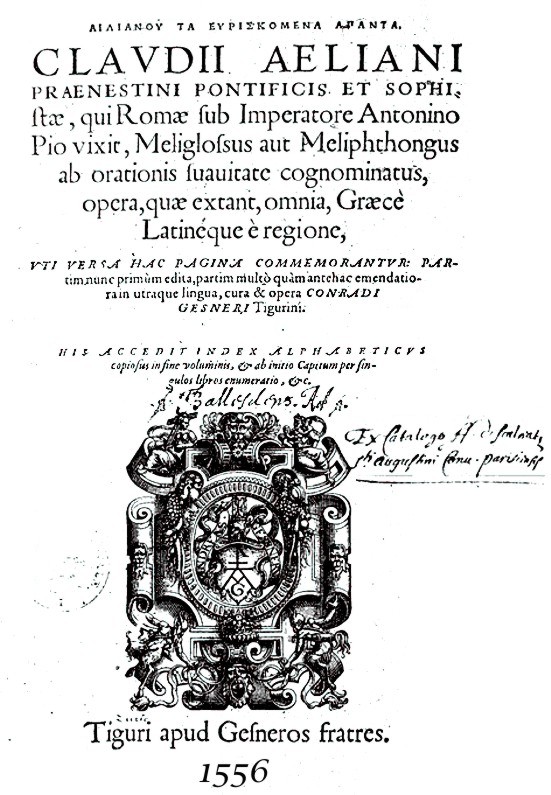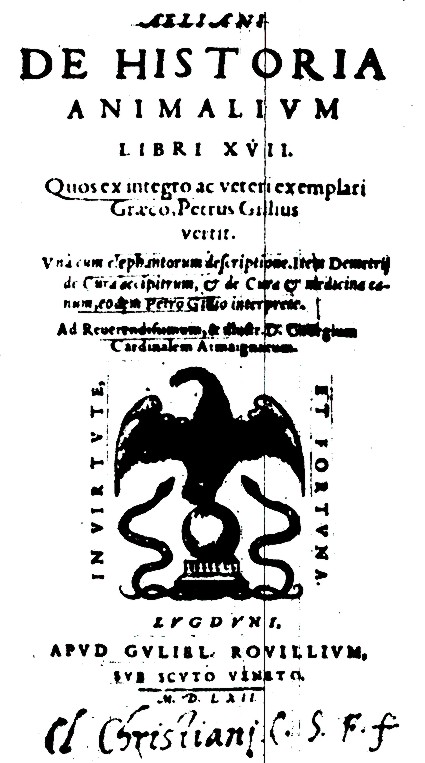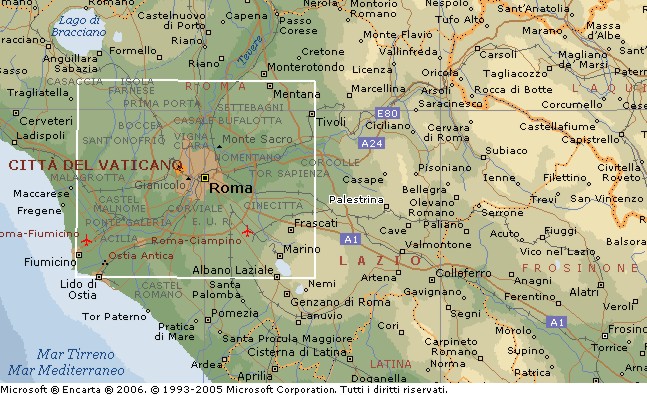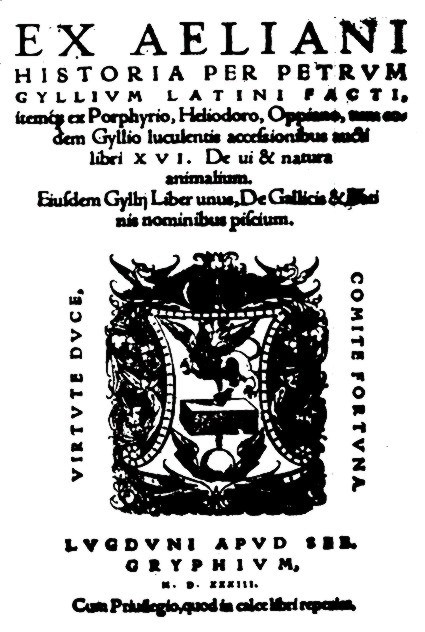Lessico
Claudio Eliano
Sofista ed erudito romano (Preneste - oggi Palestrina![]() - ca. 170 - ca. 235). Insegnò a Roma e non uscì mai dall'Italia, ma parlò e
scrisse in greco attico. Lasciò due raccolte di fatti curiosi e strani: La
natura degli animali in 17 libri e Storia
varia in 14 libri, contenenti aneddoti mitologici, letterari,
naturalistici.
- ca. 170 - ca. 235). Insegnò a Roma e non uscì mai dall'Italia, ma parlò e
scrisse in greco attico. Lasciò due raccolte di fatti curiosi e strani: La
natura degli animali in 17 libri e Storia
varia in 14 libri, contenenti aneddoti mitologici, letterari,
naturalistici.

Molto più esauriente è la biografia che Francesco Maspero presenta in apertura di una rarità bibliografica: la sua traduzione in italiano con testo greco a fronte di La natura degli animali (Biblioteca Universale Rizzoli - 1998). La riportiamo integralmente.
Possiamo
ricavare notizie sulla vita di Eliano dalla succinta biografia scritta dal suo
contemporaneo Flavio Filostrato (Vitae
sophistarum, 2, 31) [sofista
di Lemno (isola greca del Mar Egeo - sec. II-III) che insegnò ad Atene e a
Roma e che scrisse la Vita di Apollonio di Tiana, romanzo di
ispirazione neopitagorica, e le Vite dei sofisti]
e
da una breve nota che troviamo nella Suda![]() .
Flavio Filostrato ci dice che Eliano fu allievo di Pausania di Cesarea e
che quando morì aveva una sessantina d’anni. Partendo da questi dati e
considerando che il suo maestro insegnò a Roma tra il 190 e il 197 circa dC,
possiamo fissare la nascita di Eliano intorno al 170 e ritenere che la sua
morte avvenisse verso il 230/235. Benché vivesse in ambiente dove si parlava
il latino, egli apprese così bene il greco che sembrava fosse nato nel cuore
dell’Attica (Filostrato, op. cit.). Ma nella sua prosa non mancano scorrettezze che offendono
la purezza della lingua attica (cfr. Von Christ, Geschichte der griechischen Literatur, München 1924 [1961], II vol.,
p. 786 n. 5). Tuttavia egli si
considerava cittadino romano, e lo ripete più volte orgogliosamente (cfr.
Varia Historia,
2, 38; 12, 25; 14, 45). Si
vantava, afferma Filostrato, di non aver mai varcato i confini dell’Italia,
né di aver mai messo piede su una nave (vedi però De
nat. an. 11, 40). Nonostante fosse stato un allievo di Pausania, retore,
allora, di chiara fama, formatosi nella scuola di Erode Attico, Eliano si
sentiva poco portato per l’eloquenza e preferì, perciò, svolgere attività
di scrittore (Filostrato, op. cit.). Le
sue opere furono cosi apprezzate che si guadagnò il titolo di sofista
(termine che in quel tempo aveva perduto ogni connotazione negativa e indicava
semplicemente un uomo colto ed esperto nell’uso della parola). Egli esercitò
anche la
carica di ἀρχιερεύς (sommo sacerdote), probabilmente a Preneste,
ma trascorse la maggior parte della sua vita a Roma, frequentando il circolo
dell’intelligente e colta imperatrice Giulia Domna (moglie di Settimio
Severo) che aveva tra i suoi membri i migliori intellettuali della capitale
(Oppiano
.
Flavio Filostrato ci dice che Eliano fu allievo di Pausania di Cesarea e
che quando morì aveva una sessantina d’anni. Partendo da questi dati e
considerando che il suo maestro insegnò a Roma tra il 190 e il 197 circa dC,
possiamo fissare la nascita di Eliano intorno al 170 e ritenere che la sua
morte avvenisse verso il 230/235. Benché vivesse in ambiente dove si parlava
il latino, egli apprese così bene il greco che sembrava fosse nato nel cuore
dell’Attica (Filostrato, op. cit.). Ma nella sua prosa non mancano scorrettezze che offendono
la purezza della lingua attica (cfr. Von Christ, Geschichte der griechischen Literatur, München 1924 [1961], II vol.,
p. 786 n. 5). Tuttavia egli si
considerava cittadino romano, e lo ripete più volte orgogliosamente (cfr.
Varia Historia,
2, 38; 12, 25; 14, 45). Si
vantava, afferma Filostrato, di non aver mai varcato i confini dell’Italia,
né di aver mai messo piede su una nave (vedi però De
nat. an. 11, 40). Nonostante fosse stato un allievo di Pausania, retore,
allora, di chiara fama, formatosi nella scuola di Erode Attico, Eliano si
sentiva poco portato per l’eloquenza e preferì, perciò, svolgere attività
di scrittore (Filostrato, op. cit.). Le
sue opere furono cosi apprezzate che si guadagnò il titolo di sofista
(termine che in quel tempo aveva perduto ogni connotazione negativa e indicava
semplicemente un uomo colto ed esperto nell’uso della parola). Egli esercitò
anche la
carica di ἀρχιερεύς (sommo sacerdote), probabilmente a Preneste,
ma trascorse la maggior parte della sua vita a Roma, frequentando il circolo
dell’intelligente e colta imperatrice Giulia Domna (moglie di Settimio
Severo) che aveva tra i suoi membri i migliori intellettuali della capitale
(Oppiano![]() ,
Filostrato, Sereno, Galeno
,
Filostrato, Sereno, Galeno![]() ,
ecc.). Non partecipò alla vita politica, ma dopo la morte di Eliogabalo (222)
condannò, in un pamphlet che lesse
a Filostrato, il comportamento tirannico di quell’imperatore. Filostrato però
gli disse apertamente che non poteva apprezzare il fatto che Eliano non avesse
avuto il coraggio di rendere pubblico lo scritto mentre Eliogabalo era ancora
in vita (Filostrato, op. cit.).
,
ecc.). Non partecipò alla vita politica, ma dopo la morte di Eliogabalo (222)
condannò, in un pamphlet che lesse
a Filostrato, il comportamento tirannico di quell’imperatore. Filostrato però
gli disse apertamente che non poteva apprezzare il fatto che Eliano non avesse
avuto il coraggio di rendere pubblico lo scritto mentre Eliogabalo era ancora
in vita (Filostrato, op. cit.).
Quanto alla vita privata di Eliano, Filostrato ci informa che non si sposò e non ebbe figli.

Claudius
Aelianus (ca. 175 - ca. 235), often seen as just Aelian, born at Praeneste![]() , was a
Roman author and teacher of rhetoric who flourished under Septimius Severus
and probably outlived Elagabalus, who died in 222. He spoke Greek so perfectly
that he was called "honey-tongued" (meliglossos); Roman-born, he
preferred Greek authors, and wrote in a slightly archaizing Greek himself.
, was a
Roman author and teacher of rhetoric who flourished under Septimius Severus
and probably outlived Elagabalus, who died in 222. He spoke Greek so perfectly
that he was called "honey-tongued" (meliglossos); Roman-born, he
preferred Greek authors, and wrote in a slightly archaizing Greek himself.
His two chief works are valuable for the numerous quotations from the works of earlier authors, which are otherwise lost, and for the surprising lore, which offers unexpected glimpses into the Greco-Roman world-view.
De Natura Animalium
On the Nature of Animals, ("On the Characteristics of Animals" is an alternative title; usually cited, though, by its Latin title), is a curious collection, in 17 books, of brief stories of natural history, sometimes selected with an eye to conveying allegorical moral lessons, sometimes because they are just so astonishing:
"The Beaver is an amphibious creature: by day it lives hidden in rivers, but at night it roams the land, feeding itself with anything that it can find. Now it understands the reason why hunters come after it with such eagerness and impetuosity, and it puts down its head and with its teeth cuts off its testicles and throws them in their path, as a prudent man who, falling into the hands of robbers, sacrifices all that he is carrying, to save his life, and forfeits his possessions by way of ransom. If however it has already saved its life by self-castration and is again pursued, then it stands up and reveals that it offers no ground for their eager pursuit, and releases the hunters from all further exertions, for they esteem its flesh less. Often however Beavers with testicles intact, after escaping as far away as possible, have drawn in the coveted part, and with great skill and ingenuity tricked their pursuers, pretending that they no longer possessed what they were keeping in concealment."
The Loeb Classical Library introduction characterizes the book as "an appealing collection of facts and fables about the animal kingdom that invites the reader to ponder contrasts between human and animal behavior."
Aelian's
anecdotes on animals rarely depend on direct observation: they are almost
entirely taken from written sources, often Pliny the Elder, but also other
authors and works now lost, to whom he is thus a valuable witness. He is more
attentive to marine life than might be expected, though, and this seems to
reflect first-hand personal interest; he often quotes "fishermen"![]() .
At times he strikes the modern reader as thoroughly credulous, but at others
he specifically states that he is merely reporting what is told by others, and
even that he does not believe them. Aelian's work is one of the sources of
medieval natural history and of the bestiaries of the Middle Ages; in some
ways an allegory of the moral world, an Emblem Book.
.
At times he strikes the modern reader as thoroughly credulous, but at others
he specifically states that he is merely reporting what is told by others, and
even that he does not believe them. Aelian's work is one of the sources of
medieval natural history and of the bestiaries of the Middle Ages; in some
ways an allegory of the moral world, an Emblem Book.
Conrad Gessner (or Gesner), the Swiss scientist and natural historian of the Renaissance, made a Latin translation of Aelian's work, to give it a wider European audience. The latest Latin translation is that of Friderich Jacobs (1832), based on both Gesner's translation and that of Petrus Gillius (1533). An English translation by A. F. Scholfield has been published in the Loeb Classical Library.
Varia Historia
Various History — for the most part preserved only in an abridged form — is Aelian's other well-known work, a miscellany of anecdotes and biographical sketches, lists, pithy maxims, and descriptions of natural wonders and strange local customs, in 14 books, with many surprises for the cultural historian and the mythographer, anecdotes about the famous Greek philosophers, poets, historians, and playwrights; myths instructively retold. The emphasis is on various moralizing tales about heroes and rulers, athletes and wise men; reports about food and drink, different styles in dress or lovers, local habits in giving gifts or entertainments, or in religious beliefs and death customs; and comments on Greek painting. Aelian gives an account of fly fishing, using lures of red wool and feathers, of lacquerwork, serpent worship — Essentially the Various History is a Classical "magazine" in the original senses of that word. He is not perfectly trustworthy in details, and his agenda is always to inculcate culturally "correct" Stoic opinions, perhaps so that his readers will not feel guilty, but Jane Ellen Harrison found survivals of archaic rites mentioned by Aelian very illuminating in her Prolegomena to the Study of Greek Religion (1903).
Two English translations of the Various History, by Fleming (1576) and Stanley (1665) made Aelian's miscellany available to English readers; a recent English translation of Aelian's Varia Historia is by Diane Ostrom Johnson, 1997.
Other works
Considerable
fragments of two other works, On Providence and Divine Manifestations, are
preserved in the early medieval encyclopedia, the Suda![]() . Twenty
"letters from a farmer" after the manner of Alciphron are also
attributed to him. The letters are invented compositions to a fictitious
correspondent, which are a device for vignettes of agricultural and rural
life, set in Attica, though mellifluous Aelian once boasted that he had never
been outside Italy, never been aboard a ship (which is at variance, though,
with his own statement, de Nat. An. XI.40, that he had seen the bull Serapis
with his own eyes). Thus conclusions about actual agriculture in the Letters
are as likely to evoke Latium as Attica. The fragments have been edited in
1998 by D. Domingo-Foraste, but are not available in English. The Letters are
available in the Loeb Classical Library series.
. Twenty
"letters from a farmer" after the manner of Alciphron are also
attributed to him. The letters are invented compositions to a fictitious
correspondent, which are a device for vignettes of agricultural and rural
life, set in Attica, though mellifluous Aelian once boasted that he had never
been outside Italy, never been aboard a ship (which is at variance, though,
with his own statement, de Nat. An. XI.40, that he had seen the bull Serapis
with his own eyes). Thus conclusions about actual agriculture in the Letters
are as likely to evoke Latium as Attica. The fragments have been edited in
1998 by D. Domingo-Foraste, but are not available in English. The Letters are
available in the Loeb Classical Library series.

Cittadina del Lazio, in provincia di Roma; è situata in posizione panoramica, a 450 m di altitudine su uno sperone del monte Ginestro (752 m), alle propaggini dei monti Prenestini, che proprio da questo centro, l’antichissima Praeneste, traggono nome: quello odierno è di età medievale.
Città dei latini, nota e importante sin dall’VII secolo aC, cinta attorno a V secolo aC da imponenti mura poligonali (ben conservate grazie ai numerosi lavori di restauro), Palestrina passò a Roma nel IV secolo aC, pur mantenendo sostanzialmente la propria autonomia. La sua fama era legata al santuario oracolare della Fortuna Primigenia, la cui notorietà si protrasse ben oltre l’avvento del cristianesimo, sino al IV secolo dC
Direttamente sul santuario (o attorno a esso), costruzione grandiosa e complessa, con una struttura a gradoni impostata su ben sei terrazzamenti, si sviluppò poi quella che è la Palestrina storica, d’impianto medievale. Feudo del potente casato romano dei Colonna, fu lungamente contesa tra questi e il papato, quindi anche incorporata nei territori di un’altra celebre famiglia romana, quella dei Barberini. Sia i Colonna sia i Barberini attuarono decisivi interventi urbanistici di costruzione o di ristrutturazione.
Palestrina è dunque vera città d’arte e di storia, dominata da Castel San Pietro, edificato in epoca medievale sulla cima del monte Ginestro, dov’era l’antica acropoli. Dei terrazzamenti, si ricordano il Piano degli Emicicli e le sovrastanti Piana dei Fornici e Piana della Cortina.
La cattedrale romanico-gotica (XII-XIII), dedicata a Sant’Agapito, sorge sul probabile luogo del foro romano; nelle vicinanze è situata la cosiddetta Area Sacra del tempio, comunicante con la grotta oracolare dell’Antro delle Sorti. Nell’Area Sacra fu rinvenuto uno dei più celebri mosaici romani, quello detto del “Nilo”. Sulla Piana della Cortina i Barberini fecero erigere, alla metà del XVII secolo, il loro grandioso palazzo baronale, oggi sede dell’importante Museo archeologico prenestino: adiacente, e anch’essa voluta dai Barberini in sontuose forme barocche, è la chiesa di Santa Rosalia, con le tombe di famiglia.
Il turismo d’arte e l’agricoltura (cereali, prodotti ortofrutticoli) sono le basi dell’economia locali. Abitanti (palestrinesi o prenestini): 15.802 (1996).
by Dr Andrew N. Herd
The first reference to fly fishing is in Ælian’s Natural History, probably written about 200 A.D. Ælian was born in about A.D. 170 at Praeneste, where he later held a religious post, dying in about A.D. 230. At some point he became a pupil of Pausanias of Caesarea, who taught him rhetoric, and as a good student Ælian also learnt excellent Attic Greek. He later studied history under the patronage of the empress Julia Domna, and moving within her circle would have allowed him to meet not only Galen, but Oppian.
Despite his interest in the exotic, Ælian was not a traveller and he spent the vast majority of his life in Rome, which gave him easy access to the libraries he needed; he once boasted that he had never been outside Italy, had never been aboard a ship, and knew nothing of the sea; a statement which I find quite easy to believe having read his works. Ælian put his knowledge of Greek to good use when he wrote, and he drew from a vast range of reference works: his main source has been identified as being Pamphilus of Alexandria; but he also accessed a wealth of other writers including Democritus, Herodotus, Plutarch and Aristophanes.
In the seventeen volume On the Nature of Animals Ælian mixes personal observation with fact, legend and fancy drawn from earlier authors, pouncing on passing ideas like a thirsty man upon flagons of ale, with the result that there is little order in the work. His book intentionally lacked structure and it contains frequent errors many of which Ælian could have eliminated with very little effort, not least his belief that goats could breathe through their ears. However, the book is pure entertainment which is why the author saw no reason why he should not discuss elephants in one breath and dragons in the next. We should be glad of this, because in the course of his frantic rush through all of nature Ælian chanced to write these immortal lines:
I have
heard of a Macedonian way of catching fish, and it is this: between Borœa and
Thessalonica runs a river called the Astræus, and in it there are fish with
speckled skins; what the natives of the country call them you had better ask
the Macedonians. These fish feed upon a fly peculiar to the country, which
hovers on the river. It is not like the flies found elsewhere, nor does it
resemble a wasp in appearance, nor in shape would one justly describe it as a
midge or a bee, yet it has something of each of these. In boldness it is like
a fly, in size you might call it a midge, it imitates the colour of a wasp,
and it hums like a bee. The natives generally call it the Hippouros.
These flies seek their food over the river, but do not escape the observation
of the fish swimming below. When then the fish observes a fly on the surface,
it swims quietly up, afraid to stir the water above, lest it should scare away
its prey; then coming up by its shadow, it opens its mouth gently and gulps
down the fly, like a wolf carrying off a sheep from the fold or an eagle a
goose from the farmyard; having done this it goes below the rippling water.
Now though the fishermen know this, they do not use these flies at all for
bait for fish; for if a man’s hand touch them, they lose their natural
colour, their wings wither, and they become unfit food for the fish. For this
reason they have nothing to do with them, hating them for their bad character;
but they have planned a snare for the fish, and get the better of them by
their fisherman’s craft.
They fasten red (crimson red) wool around a hook, and fix onto the wool two
feathers which grow under a cock’s wattles, and which in colour are like wax.
Their rod is six feet long, and their line is the same length. Then they throw
their snare, and the fish, attracted and maddened by the colour, comes
straight at it, thinking from the pretty sight to gain a dainty mouthful; when,
however, it opens its jaws, it is caught by the hook, and enjoys a bitter
repast, a captive.
The quote above is taken from Radcliffe's Fishing from the Earliest Times, Murray (1921), and with various alterations it is the one most often reprinted, often without any credit. In his text, Radcliffe tells us that he adapted his translation from Lambert's Angling Literature in England (1881). Prior to this, a Latin translation was available in Gesner's Historia Animalium, printed in 1558, where it lay unread for nearly three centuries until Oliver rediscovered it in 1834. If you want to read an early English translation, it can be found in Westwood and Satchell's Bibliotheca Piscatoria; and finally, there is an excellent modern translation in the Loeb Classical Library Aelian On Animals.
The Macedonian fly must be the most interesting flies of all time, but imagining what it looked like is very difficult, partly because of what Ælian leaves unsaid. My own reading of his description of the Hippouros is that:
- the fly
probably didn't occur in Italy.
- it hovered.
- it was approximately midge-sized.
- it was coloured like a wasp (yellow and black), but with a body shape unlike
one
- it made a humming noise.
- and it landed on the water and floated there for long enough for fish to
take it (maybe he has this back to front and was actually describing hatching
duns - easy mistake to make).
But, Ælian makes it clear that the fishermen didn't use this fly to fish with, so the description of the Hippouros is interesting but nothing to do with the fly pattern he describes. We can't call this fly "The Hippouros Fly" because if you read the text very critically, Aelian appears to be saying that fishermen did not imitate the Hippouros:
Now though the fishermen know this, they do not use these flies at all for bait for fish; for if a man's hand touch them, they lose their natural colour, their wings wither, and they become unfit food for the fish. For this reason they have nothing to do with them, hating them for their bad character...
So you could read the next bit as a description of the fly they do use, rather than imitating the Hippouros. This would make sense, because the imitation is brown and red, while the Hippouros is yellow and black. According to our man in Rome:
...but
they have planned a snare for the fish, and get the better of them by their
fisherman's craft.
They fasten red (crimson red) wool around a hook, and fix onto the wool two
feathers which grow under a cock's wattles, and which in colour are like wax.
So you could argue on two counts that this fly is not a Hippouros imitation, in which case, it is only of theoretical interest what the Hippouros was.
If we do think it is a Hippouros imitation, then we have to square the difficult circle of reconciling a pattern with a red body with a natural fly which had a yellow body. The only way I can think of doing this is if there is a fly which changes its body colour from yellow to red, but if we think the Hippouros is being imitated here, we also have to consider Aelian's "hovering". The biggest problem here is that he was describing all this third hand. It might be that he was actually describing the ascent of duns - Ephemera danica duns and most spinners look as if they are hovering. On the other hand, it might be that he was describing a truly hovering fly; but I can't think of any patterns anywhere which imitate this sort of insect, chiefly because they are hardly of any importance to fish in their diet.
www.flyfishinghistory.com
